Thoroughly analyzing AP Inter 2nd Year Botany Model Papers and AP Inter 2nd Year Botany Question Paper March 2016 helps students identify their strengths and weaknesses.
AP Inter 2nd Year Botany Question Paper March 2016
Time: 3 Hours
Max. Marks: 60
Note: Read the following instructions carefully:
- Answer all questions of Section ‘A’. Answer any six questions out of eight in Section ‘B’ and answer any two questions out of three in Section ‘C’.
- In Section A’, questions from Sr. Nos. 1 to 10 are of ‘Very Short answer T-pe’. Each question carries two marks. Every answer may be limited to 5 lines. Answer all the questions at one place in the same order.
- In Section B, questions from Sr. Nos. 11 to 18 are of “Short Answer Type”. Each question cames four marks. Every answer may be limited to 20 lines.
- In Section C, questions from Sr. Nos. 19 to 21 are of “Long Answer Type”. Each question carries eight marks. Every answer may be limited to 60 lines.
- Draw labelled diagrams wherever necessary for questions in Sections ‘B’ and ‘C’.
Section – A
10 x 2 = 20
Note: Answer all questions. Each answer may be limited to 5 lines.
Question 1.
Define the law of limiting factors proposed by Blackman.
Answer:
If a process is conditioned by a number of separate factors, the rate of the process is limited by the factor that is present in minimal value is called Law of limiting factor.
Question 2.
Distinguish between action spectrum and absorption spectrum.
Answer:
- Graph showing the rate of photosynthesis at different wavelengths of light is called action spectrum.
- Graph showing absorption of light by different pigments is called absorption spectrum.
Question 3.
What is transduction? Who discovered it and in which organism?
Answer:
The transfer of genetic material from one bacterium to another through bacteriophage is known as transduction. It was discovered by Zinder and Lederberg in Salmonella typhi.
Question 4.
Explain the terms, phenotype, and genotype.
Answer:
The physical or external appearance of a character is called phenotype. The genetic makeup of an individual is called genotype.
![]()
Question 5.
What are the components of a transcription unit?
Answer:
- A promoter
- The structural gene
- A terminator.
Question 6.
Name any three viruses which have RNA as the genetic material.
Answer:
TMV, QB Bacteriophage, and HIV.
Question 7.
What is downstream processing?
Answer:
Separation and purification of products before they are ready for marketing is called downstream processing.
Question 8.
Name the nematode that infects the roots of tobacco plants. Name the strategy adopted to prevent this infestation.
Answer:
Meloidegyne incognita. A novel strategy adopted to prevent this infestation is process of RNA interference.
Question 9.
Name an immunosuppressive agent.
Answer:
Cyclosporin – A
It is produced by a Fungus, Trichoderma polysporum.
Question 10.
Why does “Swiss cheese’ having big holes? Name the bacteria responsible for it.
Answer:
The large holes in Swiss cheese are due to the production of large amounts of CO2 by Propionibacterium Sharman.
![]()
Section – B
6 x 4 = 24
Note: Answer any SIX questions. Each answer may be limited to 20 lines.
Question 11.
Write in brief, how plants synthesize amino acids.
Answer:
Amino acids are synthesized in plants by two ways. They are:
1. Reductive Animation: In this, Ammonia reacts with alpha Keto glutaric acid and forms Glutamic acid.
α-ketoglutaric acid + NH4+ + NADPH = Glutamate + H2O + NADP
2. Transamination: In this, transfer of an amino group from an amino acid to the keto group of a keto acid. Glutamic acid is the main acid from which the transfer of NH2 takes place and other amino acids are formed in the presence of transaminases.
Question 12.
Explain the different types of cofactors.
Answer:
Co-factors are of two types. They are:
1. Metal ion cofactors: Metallic cations get tightly attached to the apoenzyme are called metalloenzymes.
Ex: Cu2+ Cytochrome oxidase.
2. Organic cofactors: They are of two types.
- Co-enzymes: They are small organic molecules which are loosely associated with the apoenzyme.
Ex: Thiamine pyrophosphate. - Prosthetic group: They are the organic cofactors which are tightly bound to the apoenzyme.
Ex: Haem is the group for Peroxidase.
Question 13.
Write any four physiological effects of cytokinins in plants.
Answer:
- Cytokinins induce cell division.
- They help in the production of new leaves, chloroplasts in leaves, lateral shoot growth, and adventitious root formation.
- Cytokinins help to overcome apical dominance.
- They promote nutrient mobilization which helps in the delay of senescence.
- Cytokinins help in the opening of stomata by increasing the concentration of K+ ions in guard cells.
Question 14.
What is meant by plasmolysis ‘How is it practically useful to us?
Answer:
The phenomenon of shrinkage of protoplast due to osmotic diffusion of water from the cells into surrounding environment is called plasmolysis. When a cell is placed in hypertonic solution, water moves out into the external solution by osmosis, as a result protoplasm undergoes shrinkage. It leads to the separation of plasma membrane from the cell wall, so the cells become flaccid.
It does not normally occur in nature with the exception of extreme water stress or saline environments. The salting of pickles and preserving of fish and meat in salt are good examples of practical applications of this phenomenon.
Question 15.
Explain the lytic cycle with reference to certain viruses.
Answer:
T-even bacteriophages that attack the bacterium E.coli cause lysis of the cells and are called virulent phages. They show lytic cycle, which is a five-step process. They are:
- Adsorption: The tail fibres of phages help in attachment to the complementary receptor sites on the bacterial cell wall.
- Penetration: The tail sheath of phage contracts and the tail core is driven in through the bacterial cell wall. When the tip of the core reaches the plasma membrane, the DNA of the phage passes through the tail core and enters into the bacterial cell. The capsid remains outside the bacterial cell and is called ghost.
- Biosynthesis: When the phage DNA reaches the cytoplasm of the host cell, many copies of phage DNA, enzymes and capsid proteins are synthesized, using the cellular machinery of the hot cell.
- Maturation: Bacteriophage DNA and capsids are assembled into complete virions. The period of time between the infection and the appearance of the mature virus is called the eclipse period.
- Release: The plasma membrane of the host cells gets dissolved or lysed due to the viral enzyme, Lysozyme. The bacterial cell wall breaks releasing the newly produced phage particles or virions.
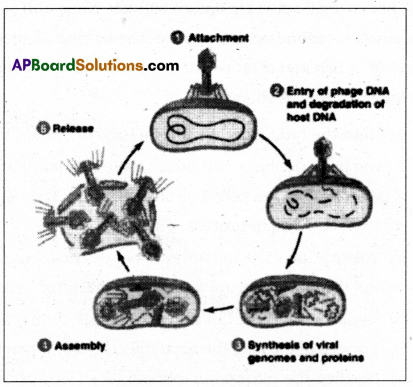
Question 16.
Define and design a test cross.
Answer:
The cross between F1 progeny and their recessive homozygous part is called test cross. It is used to test whether an individual is Homozygous or heterozygous. A monohybrid test cross gives a phenotypic ratio of 1: 1 and a dihybrid test cross gives a phenotypic ratio of 1: 1: 1: 1.
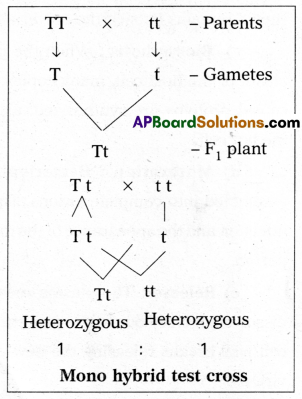
Question 17.
Write the important features of genetic code.
Answer:
- The codon is triplet. 61 codons code for amino acids and 3 codons do not code for any amino acids, hence they are called as stop codons.
- One codon codes for one amino acid, hence it is unambiguous and specific.
- Some amino acids are coded by more than one codon, hence the code is degenerate.
- The codon is read in mRNA in a contiguous fashion. There are no punctuations.
- The code is universal. Ex: UUU codes for phenylalanine in all organisms, i.e., from bacteria to human beings.
- AUG has dual functions. It codes for Methionine and also acts as initiator codon.
![]()
Question 18.
What are some biosafety issues concerned with genetically modified crops?
Answer:
- There is fear of transferring allergins or toxins to humans and animals as side effects.
- There is a risk of changing the fundamental nature of vegetables.
- They may pose a harmful effect on biodiversity and have an adverse impact on environment.
- There is a risk of gene pollution due to transfer of the new genes into related wild species through natural outcrossing. This results in the formation of superweeds and may be resistant to weedicides.
- They may bring about changes in natural evolutionary patterns.
Section-C
12 x 8 = 16
Note: Answer any two questions. Each answer may be limited to 60 lines.
Question 19.
Explain the reactions of Krebs cycle.
Answer:
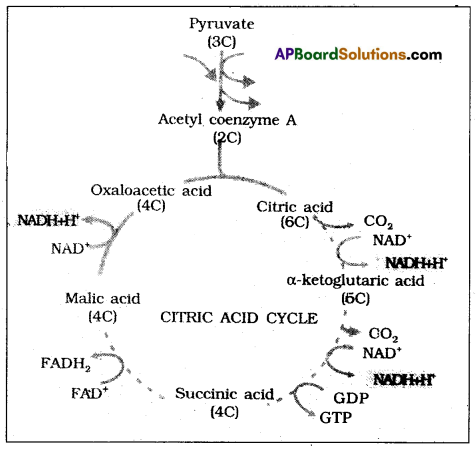
The cetyl CoA eaters into the [mitochondrial matrix a cyclic pathway tricarboxylic acid cycle, more commonly called krebs cycle after the scientist Hans Krebs who first elucidated it.
1. Condensation: In this acetyl CoA condenses with oxaloacetic acid and water to yield citric acid in the presence of citrate synthetase and CoA is released. :
![]()
2. Dehydration: Citric acid looses water molecule to yield cis aconitic acid in the presence of aconitase.

3. Hydration: A water molecule is added to cisaconic acid to yield isocitric acid in the presence of a conitase.
![]()
4. Oxidation I: Isocitric acid undergoes oxidation in the presence of dehydrogenase to yield succinic acid

5. Decarboxylation: Oxalosuccinic acid undergoes decarboxylation in the presence of decarboxylase to form α-keto glutaric acid.

6. Oxidation II, decarboxylation: α – keto glutaric acid undergoes oxidation and decarboxylation in the presence of dehydrogenase and condenses with co..A to form succinyl Co. A.

7. Cleavage: Succinyl Co.A splits into succinic acid and Co.A in the presence of thiokinase to form succinic acid. The energy released is utilised to from ATP from ADP and PI.

8. Oxidation – III: Succinic acid undergoes oxidation and forms Fumaric acid in the presence of succinic dehydrogenase.

9. Hydration: A water molecule is alcohol to Fumaric acid in the presence of Fumarase to form Malic acid.
![]()
10. Oxidation IV: Malic acid undergoes oxidation in the presence of malic dehydrogenase to form oxaloacetic acid.

In TCA cycle, for every 2 molecules of Acetyl Co.A undergoing oxidation, 2 ATP 8 NADPH+ H+, 2FADH2 molecules are formed.
Question 20.
Explain briefly the various processes of recombinant DNA technology.
Answer:
The important method in. recombinant DNA technology are performed through genetic engineering.
They are:
- Isolation of a desired gene
- Insertion of an isolated gene into a suitable vector
- Introduction of recombinant vector into a host and
- Selection of the transformed host cells.
I) Isolation of a desired gene:
- The desired gene is isolated from the donor cell. Normally bacteria are the source of desired genes.
- The cell walls of bacteria are degraded with the help of enzymes.
- The cell membranes are lysed with the help of detergents.
- By treating the cellular constituents with phenols and suitable nucleases and by subjecting to gradient centrifugation, pure DNA is isolated.
- The purified DNA is cut into a number of fragments by restriction endonucleases.
- The restriction enzymes cleave DNA molecules in two ways.
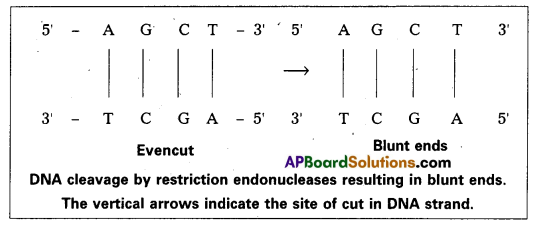
- In one way they cut both strands of DNA at exactly opposite points to each other. This results in DNA fragments with blunt ends or flush ends, where two strands end at the same point. Such cut is generally termed as even cut.
- But commonly, most enzymes cut the two strands of DNA double helix at different locations. Such a cleavage Is generally termed as staggered cut. This generates protruding ends i.e., one strand of DNA double helix extends some bases beyond the other. Since the target site is palindromic in nature, the protruding ends generated by such a cleavage have a complementary base sequence.
As a result, they readily pair with each other and such ends are called cohesive or sticky ends. This stickyness of the ends facilitates the action of the enzyme DNA ligase. When cut by the same restriction enzyme, the resultant DNA fragments have the same kind of ‘sticky ends’ and these can be joined together readily by using DNA ligases.
E.g.: The restriction enzyme E coRI.
E – The first letter, represents the name of genus Escherichia.
Co – The next two letters, represent the species Esche richia CoU.
The letter R is derived from the name of strain.
Roman numbers following the names indicate the order in which the enzymes were isolated from the strain of bacteria. This enzyme specifically recognises GAA sites on the DNA and cuts it between G and A (G ↓, A)

The resultant fragments are separated from each other by gel electrophoresis.
The desired fragments are selected by Southern blotting technique.
II) Insertion of isolated gene into a suitable vector:
- The selected fragments of DNA are inserted into a suitable vector to produce a large number of copies of genes.
- This is called gene cloning.
- There are two major types of vectors, namely plasmids and bacteriophages.
- Among the two types, plasmids are the ideal cloning vectors.
- To isolate a plasmid, the Bacterial cell is treated with EDTA (Ethylene diamine tetra acetic acid) along with lysozyme enzyme to digest the cell wall.
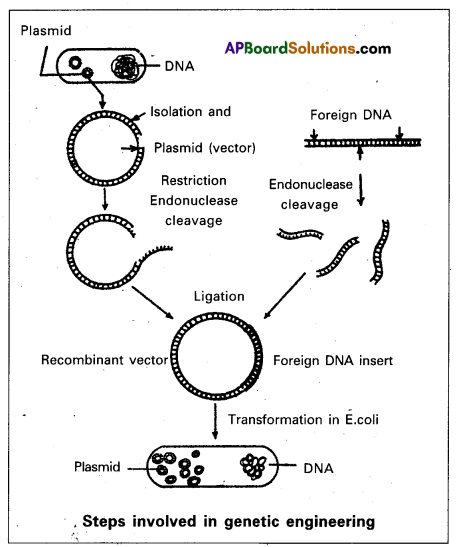
- Then the bacterial cell is subjected to centrifugation in sodium lauryl sulphate to separate the plasmid.
- The plasmid DNA is cut with the help of restriction endonuclease.
- The circular plasmid is converted into a linear molecule having sticky ends.
- The two sticky ends of linear plasmid are joined to the ends of desired gene by DNA ligase.
- The plasmid containing foreign DNA segments is called recombinant DNA (r DNA) or Chimeric DNA.
III) Introduction of recombinant vector into a suitable host:
- The rDNA molecule is introduced into suitable bacterial host cells by transformation.
- The cell containing r DNA is called transformed cell.
- Bacterial cell walls are not permeable to recombinant vectors, but keeping in die. Calcium chloride renders the bacterial cell wall permeable to recombinant vectors.
- The rDNA replicates within the host cell.
- The transformed cell grows on the culture medium. Each nature of gene daughter cell contains r DNA.
IV) Selection of transformed host cells:
1) Selection of transformed cells depends on the which is cloned.
2) It can be done in two ways. They are
a) Without using probes
b) By using probes.
a) Without using probes:
If the gene is cloned for antibiotic resistance, the cells are first incubated on a medium without antibiotic for one hour, to allow the antibiotic resistance gene to be expressed. Then the cells are placed on a medium with an antibiotic for selection of colonies containing rDNA, The cells which have expressed the gene will survive and the others die.
b) By using probes: When transformed cells are cultured on the nutrient medium, several cells are produced. To select the cells containing the desired gene colony hybridization method is used. In this gene specific probes are used. A probe is a small fragment of single-stranded RNA or DNA which is tagged with radioactive, molecules. It can search out complimentary DNA sequences from an organism.
![]()
Question 21.
Describe the tissue culture technique. What are the advantages of tissue culture over conventional methods of plant breeding in crop improvement programmes?
Answer:
The main steps in breeding a new genetic variety of a crop are:
1. Collection of Variability: Genetic variability is the root of any breeding programme. Collection and preservation of all the different wild varieties, species and relatives of cultivated species is a prerequisite for effective exploitation of natural genes available in the populations. The entire collection having all the diverse alleles for all genes in a given crop is called Germplasm collection.
2. Evaluation and selection of parents: The germplasm is evaluated so as to identify plants with desirable characteristics. The selected plants are multiplied and are used. Purelines are created wherever desirable.
3. Cross Hybridisation among the selected parents: After emasculation (Removal of Anthers from bisexual flower of a female parent) the female flowers are enclosed in a polythene bag to prevent undesired cross-pollination. Pollen grains are collected from the male parent with the help of a brush and are transferred to the surface of the stigma thus cross-pollination is affected artificially.
4. Selection and Testing of superior recombinants: It Involves selecting among the progeny of hybrids, those plants that have the desired character combination. The selection process requires careful scientific evaluation of the progeny. Due to this, plants that are superior to both the parents are obtained. These are self-pollinated for several generations till they reach homozygosity.
5. Testing, release, and commercialisation of new characters:
The newly selected lines are evaluated for their yield and other traits of quality, disease resistance, etc. It is done by growing these in research fields and recording their performance under ideal fertilizer application, irrigation, and other crop management practices. It is followed by testing the materials in farmers’ fields for at least 3 growing seasons at several places in the country, in all agroclimatic zones. Finally, they are distributed to farmers as a new variety.